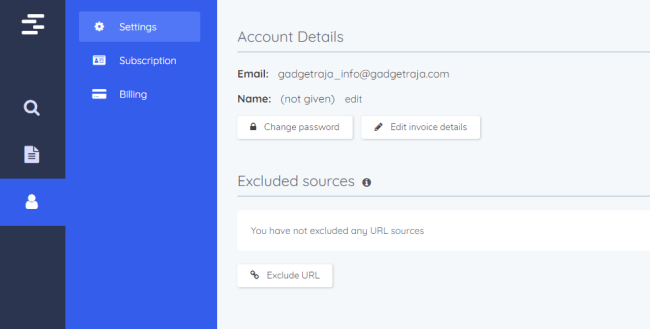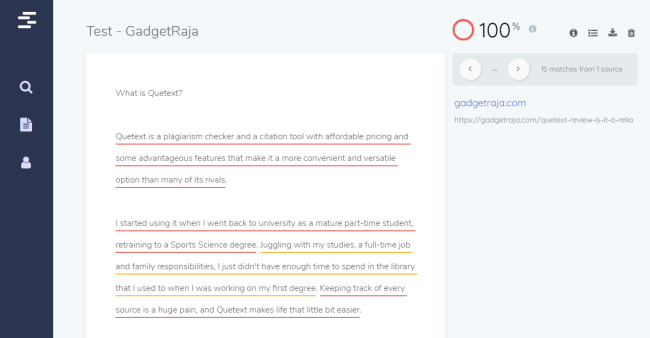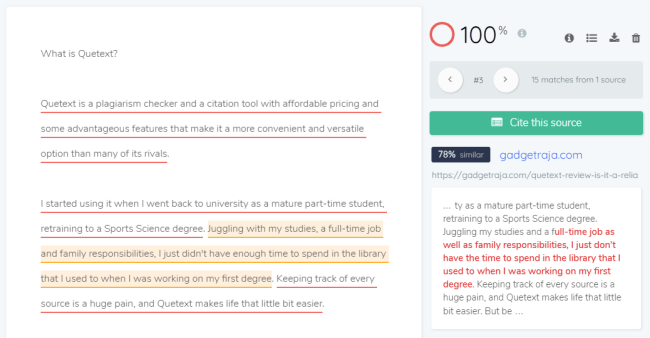What Is Quetext
Had enough of shoddy plagiarism checkers and complex citation tools? Time to wave them goodbye. With Quetext, you’ve got a free plagiarism detector and citation wizard right at your fingertips—ready to serve students, bloggers, writers, and web owners alike. No need to splash the cash or wrangle with clumsy interfaces. Quetext have nixed the frustrating aspects of document analysis—you know, the constant worry about missed citations, the stress of overlooking duplicated content—and made the process as smooth as butter. It’s more than just a plagiarism check; it’s a ticket to a simpler, more efficient writing life. And the best part? Quetext isn’t your granddad’s duplicate content checker. Quetext’s unique plagiarism algorithm delves deep into the semantics of your text, raising the bar for detection accuracy. Forget the simple sniff tests that only scratch the surface. Quetext dive in deep, sweeping away duplicated content with finesse and precision.
Sick and tired of fretting about plagiarism checks gone wrong? Invested a small fortune on an advanced content writing tool, only to have it mess up plagiarism detection? That’s a real downer. But hold on, there’s no need to settle for less when the solution is just a few clicks away. Enter Quetext – the plagiarism checker that’s been creating waves in the content world.
This is no average plagiarism checker. Quetext has shown the door to all the frustrating aspects of plagiarism checking – false positives, overlooked matches, cumbersome interfaces – and has simplified the whole process. What you get is a clean, efficient, and accurate plagiarism checker that delivers what it promises.
Unlike many others, Quetext doesn’t just skim through the surface. It digs deep, comparing your text with millions of documents, articles, and books in its database to ensure nothing slips through. Plus, the intelligent design includes a citation assistant to help you steer clear of accidental plagiarism. No false alarms. No missed matches.
So what’s the verdict? In an era where original content is king, we’re placing our bets on Quetext. Stay tuned for our in-depth review of why Quetext is our top pick for plagiarism checking this year, and every year. Believe us when we say, the need to produce original, plagiarism-free content is in. And Quetext? It’s our go-to weapon of choice.
Table of Contents
- What Is Quetext
- Quetext Review 2023
- How Do Plagiarism Checking Tools Work?
- How Quetext Works?
- Important Features of Quetext
- Deepsearch Technology – What It Is?
- Is Quetext Legit?
- Is Quetext Reliable?
- Is Quetext Safe?
- How Accurate Is Quetext?
- Pricing of Quetext
- Exactly What Is Plagiarism?
- Importance of Plagiarism Tools like Quetext
- Why It’s Necessary to Write Detailed and Plagiarism Free Articles?
- What Are the Consequences of Plagiarism in College?
- So What Contributes to Quality Unique Content?
- Should You Use Quetext
Quetext Review 2023

First of all, I would like to make it abundantly clear that this plagiarism detection software review is in no way sponsored by Quetext. Regardless of what I am about to share with you in this review, these are my personal thoughts that are based on my personal experience with this . I have tested both the free version and the premium version of this tool with my own money.
How Do Plagiarism Checking Tools Work?
Are you living in constant dread of unintentionally committing the cardinal sin of academia or professional writing – plagiarism? Ain’t nobody got time for that! In comes your knight in shining armor: Plagiarism checking tools. Modern plagiarism-checking tools boasting their advanced and often proprietary algorithms can save your well-crafted paper from being marred by unintended duplication. But what makes this tool tick?
The magic behind plagiarism checking tools, like Quetext, isn’t as enigmatic as you’d imagine. These clever pieces of software sweep across millions – heck, billions – of web pages, scholarly articles, books, and all manner of written content. Just like that fire pit’s design pulls smoke away from your face, these tools pull away potential matches from the enormity of the world wide web.

They put your text under a microscope, dissecting it into chunks, and cross-referencing these with their colossal database. Each sentence is scrutinized for matching phrases, identical syntax, and similar structures. It’s like scanning a haystack for that elusive needle, except, these tools have an uncanny knack for finding it.
Plus, much like how our preferred smokeless fire pits have that secondary benefit of making fire starting a breeze, good plagiarism tools offer more than just duplicate detection. They help you with grammar and spell check, citation assistance, and even readability improvements. It’s the full package – no more juggling between different apps.
In essence, plagiarism checking tools act as your guard dog, ensuring your hard work doesn’t get tainted by accidental plagiarism. And with advanced features, they’re as essential to your writing process as a good fire pit is to a successful bonfire night. The ease, simplicity, and comprehensive features of tools like Quetext make them a no-brainer for writers. Next time you hit ‘save’ on that document, make sure you’ve run it through a reliable plagiarism checker first. No duplicates. No trouble.
How Quetext Works?
Remember the painful experience of sifting through countless web pages trying to ensure your work is original? That’s the old-school way, and it sucks, right? Quetext changes all that. It’s thrown out the tedious task of manual checking and replaced it with cutting-edge technology that makes plagiarism checking a walk in the park.
Let’s get into the nitty-gritty of how it operates. Quetext uses an AI-driven, contextual checking engine. It’s not just looking for direct copies, but it’s clever enough to understand the meaning behind your words, comparing it with over 35 billion cached web pages. No more petty errors slipping through the cracks.

But that’s not all. Their proprietary DeepSearch™ technology takes it a step further. It scans your work, checking sentence structures, and looking for matching phrases across an enormous database. Now that’s deep!
Not to forget the grammatical analysis feature. It’s like having a grammar guru sitting next to you, pointing out all the syntax hiccups and misspelled words. Say goodbye to embarrassing grammatical blunders.
And the cherry on top? The ColorGrade™ feedback system. This isn’t your average ‘red for wrong, green for right’ highlighting tool. It provides nuanced feedback, showing you the seriousness of your mistakes in vibrant hues. It’s as if your text is turned into a color-coded heatmap of potential plagiarism and grammar issues.
So, here’s the full scoop. With Quetext, you’re not just avoiding plagiarism, you’re embracing a smarter way of producing quality content. And that’s why we’re all in on Quetext for this school year, this work project, and this year, because the primal instinct to create original work is paramount, and Quetext is our preferred ally.
Important Features of Quetext
I subscribed to the premium version of Quetext because it offers several convenience improvements like advanced plagiarism detection over the free subscription plan.
Firstly, when I’m using the free plagiarism checker tool to flag up sources that I have extracted information from (so that I can make sure that I’ve cited them correctly), I can exclude sources that I don’t want to use.

This is handy if there are papers published on multiple platforms since I can use the ones which are considered to be high-quality sources and ignore the lower quality/scraped journals. I can also ignore secondary sources, Wikipedia, and question-and-answer sites which aren’t considered trustworthy.
Secondly, it’s handy to be able to submit multiple papers at once. Additionally, the Quetext plagiarism detector allows you to scan documents with up to 25,000 words.
The 25,000-word count limit is more than generous enough for me! It’s also handy being able to upload a document instead of needing to copy-paste and to be able to download reports with automatic citings and comments.

Thirdly, I’ve noticed that I have a habit of using common turns of phrase far too much. While that isn’t exactly the same as plagiarism, and even the pickiest of editors has never accused me of copying for starting a post with “Training for a triathlon can be intimidating” or “Training for a martial arts tournament can be intimidating,” those phrases are something that they frequently edit out.

I must confess, they’re lazy, and they aren’t a hallmark of good writing. Having access to my own convenient plagiarism checker (i.e., quetext)has helped me identify when I use lazy phrases like that, and I can save the reports and come back to my work a day or so later try to rework those sections.
Fourthly, thanks to this tool’s advanced plagiarism check, I have become much more confident in creative writing because I’ve had my bad habits pointed out to me by an impartial machine.
No offense to the editors; they are great at their jobs. However, there is something about getting negative feedback from a human that feels more personal, and sometimes it does hurt the ego. Machines are objective, and that has helped me a lot.
I highly recommend the premium but also the free version of this free plagiarism checker to anyone who wants to become a better writer – both for academic and professional purposes.
Deepsearch Technology – What It Is?
Deepsearch technology is Quetext’s exclusive plagiarism detection engine that matches your content against up to billions of cached web pages and texts from more than a million available journals, books, and even live search results.
Through the most advanced text-matching algorithm, Deepsearch technology compares the text from your work with the one that has already been published on the web.
If your result displays that your work is almost identical to something that was already published, with the same wording and the same Sources, you have got yourself a serious copyright infringement and plagiarism problem.
The good news is that Quetext helps uncover plagiarism that you might not have been aware of, as well as help you understand how to avoid it in the future.
One of the best features of Quetext is that the plagiarism checker doesn’t just search for the occurrence of the same words!
With the addition of keywords in your articles, you can also use the Quetext free plagiarism checker to check how often your keywords appear throughout the work.
For each new match, the tool shows you the percentage of commonality and the number of occurrences.
With the premium version of Quetext, when you export the report, it will give you a full overlap with your previous report, including the word count and percentage of commonality.
Importantly, the tool allows you to export your report into MS Word documents, CSV files, or for direct copying and pasting.
Is Quetext Legit?
Yes, it’s legit and safe to use. Unlike many free plagiarism checkers that can only check documents up to 1000 words, Quetext allows you to upload gigantic files ( up to 20000 words in total) and detects a wide range of cheating attempts. Utilizing their renowned plagiarism detection DeepSearch™ Technology, Quetext compares your article with millions of other articles on the web, and even if you copy-paste paragraphs from the Internet, this tool will find it. Quetext is designed to be fast, efficient, easy to use, and comprehensible, even to those who’ve never used a plagiarism detection tool.
Is Quetext Reliable?
You may wonder if Quetext is reliable and how its accuracy compares to other checkers. Well, it is the most reliable, fastest, and powerful plagiarism checker out there. Offering you the most extensive database, integration support, and advanced algorithms-based scanning system, this is the best tool to use when writing an essay, article, or any other academic paper.
Is Quetext Safe?
Yes. Quetext does not store users’ personal info and respects the privacy of its users. And unlike many other free plagiarism checkers, Quetext does not bombard you with ads ensuring that your browsing experience is not interrupted.
How Accurate Is Quetext?
Applying the contextual plagiarism algorithm provided by Quetext, one blog article will be checked in less than 60 seconds. The contextual plagiarism algorithm is powerful enough to check large chunks of text, and it has a really fast processing speed.
Before committing to a paper or essay, writers want to be sure that their sources are correctly documented. Quetext makes this process much easier, with a simple and straightforward interface where you type or paste the text into a box and then click Check. The system will automatically find the sources and show them to you in a list that is quite similar to a visual table of contents. And just like the more widely used plagiarism checker – Turnitin, Quetext provides its users with an option to download their reports in PDF format and an interactive interface to make necessary edits online.
Pricing of Quetext
Quetext offers two pricing plans or, better to say, subscription plans.
Below you can find more details on their plans along with a comparison table.
The Free Plan
You can signup up for Quetext for free and can enjoy the benefits of their free account. With a free subscription, you scan a maximum of 500 words at once. There is also a limit of 3 scans, which means you can scan a maximum of 1500 words with your free account. Furthermore, you cannot upload documents, which means you will have to copy and paste your content into this tool. You also cannot download the reports or exclude the sources.
The biggest disadvantage of a free subscription is that your content scans won’t use the DeepSearch™ technology, so you can assume that your scan results won’t be 100% true.
The Professional Plan
This plan starts at just $ 9.99 per month and gives you access to all features of this tool. You get unlimited word scan limits along with unlimited reports limits. You can scan documents with up to 25,000 words and can download the PDF report with highlighted content, which Quetext believes is plagiarized from another source.
Additionally, you get the option to exclude the sources for citation along with access to premium after-sales support.
| Free | Professional | Features |
|---|---|---|
| 500 Words | 25,000 Words | Limit |
| No | Yes | Upload to check |
| No | Yes | Download Reports |
| No | Yes | DeepSearch™ |
| Yes | Yes | Basic Search |
| 3 | No Limit | Scans |
| 3 | No Limit | Reports |
| No, Only Basic | Yes | Premium Support |
Exactly What Is Plagiarism?
Growing up, I held the notion that plagiarism entailed nothing more than lifting someone else’s work and repurposing it as my own. This false assumption was shattered once I enrolled in university, where my English and History professors vehemently warned against such unethical practices. Their unambiguous stance on the matter made me realize the importance of exercising utmost caution when incorporating external sources into my academic work.

As I progressed through my academic journey, the significance of appropriate citations and the need for 100% originality became even more pronounced. While professors were more lenient towards students who were learning the ropes of proper citation, university-level assignments left no room for error. I vividly recall a professor who reiterated that he would take swift action against any form of plagiarism, including possible expulsion from the course. Such a warning was intimidating, to say the least, but it effectively instilled in me the value of avoiding such unethical practices at all costs throughout my student life.
Importance of Plagiarism Tools like Quetext
During my university years as a computer science nerd, I’ve seen plenty of coding comrades bite the dust due to copy-paste mishaps. Was the coding assignment worth it? Definitely not! Plagiarism? A reckless move.
Enter the digital guardian angel, plagiarism tools like Quetext. These are not just some fancy-sounding tech tools that take up space on your computer, but they’re lifesavers. Here’s why.

1. Say No to Plagiarism Accidents – They’ve waved goodbye to the traditional horrors of plagiarism—the unintentional copying, the overlooked citation, the sneaky paraphrase. Tools like Quetext scans your work like a hawk, identifying and highlighting potential plagiarism pitfalls. And they’re super thorough, running comparisons against a massive database of academic papers, web content, and more. No more accidental plagiarism. No more sweaty palms.
2. Get Your Citation Game On – Different assignments, different citation styles. APA, MLA, Chicago—sound familiar? They should. These bad boys are the lifeblood of academic writing, and getting them wrong? Not cool. But Quetext takes that worry off your plate. It not only detects plagiarism but also helps you nail your citations, every single time. They say citation is the sincerest form of flattery in academia—let’s keep it that way.
3. The Confidence of Originality – Ever had that niggling doubt about your work’s originality? Quetext kicks that doubt to the curb. It offers a detailed originality report for every document you scan, offering you a confident strut into your professor’s office. There’s nothing quite like the assurance of knowing your work is 100% your own. Pure authenticity. No fear.
4. Saves You Time- Coding, writing, revising, it’s all time-consuming. Who needs the added task of manually checking for plagiarism? Plagiarism checkers like Quetext are like your personal plagiarism-proofing concierge. Paste your work, hit scan, and sip your coffee while Quetext does the heavy lifting. Easy peasy.
5. Boosts Your Academic Reputation – And lastly, don’t you want to stand tall and proud as the integrity champ of your class? Of course, you do. Quetext helps you maintain a clean academic record and protect your reputation. No plagiarism scandals here, thank you very much.
So there you have it. This semester, this year, and for all your academic years, we’re endorsing the ultimate need for a plagiarism checker. And Quetext, with all its clever features, is our preferred shield. You wouldn’t venture out in a storm without an umbrella, would you? Don’t venture into academic writing without Quetext.
Why It’s Necessary to Write Detailed and Plagiarism Free Articles?
In today’s digital, content-churning age, are you still spinning out subpar, recycled posts? You know, the ones that just scrape together a semblance of information from multiple sources without adding any unique flavor? No, that’s not gonna cut it. Let’s face it, you’ve invested in the best blogging platform, got a bang-on domain, and designed a visually appealing site. Now, don’t let it all fall flat with copy-pasted, mundane articles.
- Boosting SEO Ranking: Search engines adore unique content. They’ve chucked out the archaic criteria of stuffing keywords and embraced quality. Writing detailed, original articles improves your chances of ranking higher. Think about it – no duplicated content means the Google gods might just be in your favor.
- Building Reputation: Your articles are your voice online. Posting in-depth, plagiarism-free content demonstrates your expertise and credibility. Your audience can see through fluff. Give them well-researched, thought-provoking posts, and they’ll stick around, guaranteed.
- Avoiding Legal Hassles: Ever considered the legal headaches that come with copied content? Yeah, copyright infringement is not a party you want to attend. Steer clear of plagiarized material and save yourself from a nasty lawsuit.
- Promoting Creativity: Writing detailed articles from scratch sparks your creativity. It pushes you to think, explore, and innovate. The brain loves a good challenge. So why not treat it with some intellectual stimulation instead of the regurgitated content?
- Gaining Reader Trust: When you dish out quality, detailed, and plagiarism-free content, your readers recognize your effort. They know you respect their time and intelligence. And that builds trust, an essential ingredient for any successful blog or site.
And, here’s where Quetext comes into play. It’s your knight in shining armor, making sure every piece you write is as original as your thoughts. So the final take? This year, this season, and this moment, we’re advocating for the habit of writing detailed, plagiarism-free articles. Quetext is your perfect partner on this journey. So, why wait? Ditch the copy-paste, embrace originality, and see the difference for yourself.
What Are the Consequences of Plagiarism in College?
College is hard, and if you are thinking about taking the easy way out by copying someone else’s work, you might want to reconsider. Seriously, do you really want to mess up your academic life with a plagiarism charge? Nah, we didn’t think so. In the world of academia, where honor and integrity hold paramount importance, there’s absolutely no room for plagiarism.
Why? Well, plagiarism is essentially academic theft. It’s taking someone else’s hard work, passing it off as your own, and grabbing the credit for it. Not cool, right? Plagiarism has some severe consequences and they’re not the kind you can shrug off with a simple “my bad.”
First off, there’s a good chance you could fail the assignment. Sounds unpleasant? It gets worse. You might even flunk the entire course. Many educational institutions have a zero-tolerance policy towards plagiarism, so don’t test their patience.
Even if you somehow dodge that bullet, your academic reputation will be stained. And this is not something you can wash off with a round of apologies. It can follow you throughout your academic journey, affecting your chances for internships, scholarships, and maybe even future job prospects.
And let’s not forget the legal consequences. Plagiarism is considered intellectual property theft. That means if you’re caught plagiarizing, you could potentially face legal ramifications. Fines, lawsuits, and yes, possibly even jail time.
So, what’s the bottom line here? It’s simple: avoid plagiarism at all costs. In this day and age, when plagiarism detection tools like Quetext are readily available, there’s no excuse for academic dishonesty. Quetext, with its advanced technology and user-friendly interface, can help you ensure that all your submissions are 100% original. No copycats. No shame.
So What Contributes to Quality Unique Content?
Ah, the million-dollar question! You’ve invested all this effort and time into creating your awesome blog or website, only to dampen its impact with subpar, duplicate content? That’s not gonna fly. Today, with countless resources and tools like Quetext, creating quality, unique content is no Herculean task.
The traditional hurdles of creating fresh and unique content—researching, rephrasing, and ensuring originality—have been significantly simplified. It’s no longer about recycling the same old ideas and praying the plagiarism gods turn a blind eye. In fact, with the right tools, creating unique content can be as straightforward as 1,2,3.
How, you ask? Well, different platforms offer different features, but all aim to make the creation of unique content painless. For instance, Quetext, a handy tool in the fight against plagiarism, goes above and beyond to identify similar content across billions of web pages. Moreover, the clever algorithms not only catch any potential plagiarism but also suggest ways to rephrase and make your content more original. It’s a win-win: no plagiarism, no hassle.
Should You Use Quetext
Quetext stands out as an exemplary tool amidst the array of plagiarism detection solutions available online. Its competitive pricing, coupled with its user-friendly nature, sets it apart from its rivals. The intuitive interface of this potent application caters to users of all levels, making the process of scanning documents for duplicity effortless. Should this review of Quetext prove useful in your academic or professional circle, we implore you to share it with your esteemed colleagues and classmates.